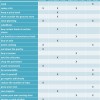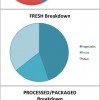Taking Control of Our Grocery Spending
November 30th, 2012 | 28 Comments
Last month we were way over our grocery spending and this month we are way, way over! Two months in a row is real red flag. This is such a big chunk of our budget that these large overages are affecting our bottom line – the only reason we’ve been in the black the last two month has been our yet-unincorporated cost-of-living raises from September. Looking back in Mint, it seems that our grocery spending spikes every fall/winter – usually November, sometimes October or December. Maybe it’s the additional social events around the holidays or the seasonal baking – whatever the reason, it’s a trend I can see over in the fourth year now. And I’m not the only one!
Whatever the reason, though, we have to exercise some self-control and apply some of the spending-reduction strategies we’ve become lax about to get back under budget. When I discussed these plans with Kyle, he said that he didn’t want to do any additional work around the grocery shopping because “I don’t think I’ve been overspending – my eating hasn’t changed.” After he made this protestation several times and I reassured him each time that I wasn’t accusing him of overspending, I realized he was passive-aggressively blaming me for the overspending! (Probably a reasonable guess – I’ve been buying a lot of almond flour and coconut oil, both of which are quite pricey.)
Here are the new disciplines I am going to implement to carry us through this winter without blowing our grocery budget every month. I’ll update at the start of January on how well we adhered to these disciplines and then again monthly until we get through this danger period!

1) Continuously keep a shopping list.
We do shop with a list nearly every time, but we tend to make the list right before heading out to the store. The result is that we often forget items, which means additional shopping trips (usually without lists) and that can tack on additional items that could have been delayed. When we run out to the store we go to the one closest to us instead of the one with the best prices. I’ll make a “usual suspects” list to print out and keep in the kitchen and then jot down additions and cross out what we don’t need as the week goes on.
2) Track every single item we purchase and look at the aggregated data.
As of now we track all our spending and keep our receipts, but I only intermittently make entries into our pricebook and to this point we haven’t made master lists of everything we’ve bought. I have in the past calculated the cost of all my meals, but this is slightly different as I’ll only be tracking new spending, not the use of things we already own.
I will aggregate all the individual items into these groups (might edit as the month goes on) and determine which categories are the major moneysucks and which are the big targets for cost reduction.
- fresh
- vegetables
- fruits
- meat
- nuts/seeds
- canned
- vegetables
- fruits
- meat
- beans
- processed/packaged
- dairy
- grains/starch
- barely-food
- condiments and spices
- non-food
- personal care
- household
3) Shop on a consistent day of the week.
I want to make Saturday our primary (if not only) shopping day of the week. By getting all the shopping out of the way on Saturday morning, I have time during the rest of the day to do the chopping and produce preparation before the produce starts going soft. We usually go through certain produce items in 5-8 days so I think once per week will fit in well with our current eating patterns.
4) Check the weekly specials (and compare with my pricebook) to buy on sale.
For a while I was checking out the weekly specials at our local stores so that I could buy sale items, but I haven’t done it in months. My pricebook, though incomplete/slightly out of date, is still pretty useful for this sort of thing. Often the grocery store sale prices are still not as low as what we can get at Costco or ALDI. I’ll note which of our typical buys are on sale using the weekly specials available online from Kroger and Harris Teeter, then cross-check the sale price against the price I’ve gotten in the past at other stores, and add the sale items to our shopping list if they are the best price.
5) Add in some meal planning.
Kyle and I eat the same things over and over again so we don’t really meal plan per se. I’d like to get back into using our crock pot, though, so every week of this month I’ll pick out a new batch-cooking recipe to try out. I think these recipes are usually cheaper than what I make in smaller batches day-to-day.
6) Visit low-cost stores first.
Every Saturday I plan to hit the farmer’s market, then Costco, then Kroger (then Harris Teeter and Target, if necessary) – that way I can adjust the rest of my buying around what I get at the farmer’s market. We stopped shopping at ALDI when we moved but I think we should resume going there once per month near the beginning of the month. Every week our list will just cascade from the lower-cost vendors to the higher cost so we don’t have to guess if we can get something for less.
7) Evaluate additional sources for groceries.
I’ll set a goal to visit one food retailer that we haven’t used before to compare some prices this month. There are several in my area (ethnic grocery stores, Trader Joe’s, Food Lion) plus I’ve never ordered food off the internet (Amazon) so we have plenty of options.
This challenge is going to be especially hard to implement starting this December as we are only in town for about three weeks. If we have to buy groceries when we are in CA, as we have many times in the past, that will jack up our spending. Plus there may be some waste if we can’t prioritize our fridge and pantry to be eaten down before we leave on our trip. Still, there is no better time to start than the present.
At the beginning of January I’ll update you on how we did on each of these seven steps, including the table of the money we spent on various categories and how I want to adjust our spending based on that data.
What practices do you tighten up when you realize your grocery spending or another budget category is out of control? How structured are you in your grocery listing and shopping?
photo from Free Digital Photos
Filed under: food · Tags: budgeting, groceries, lists, overspending
Recent Comments
- Adam on Home Equity Is Funny Money
"Hi Emily - I just stumbled upon your blog. Great post! Up in Canada this is a…" - Emily on Home Equity Is Funny Money
"I agree that an appraisal is the best number to work with. I can't think of why …" - JL on Home Equity Is Funny Money
"I only note it as round numbers, in $50k or $100k estimates. I also usually upda…" - We Maxed Out All Our Retirement Accounts for the First Time! - Evolving Personal Finance | Evolving Personal Finance on Avoiding an Expensive 401(k) Plan through Self-Employment
"[…] was the first year that we contributed to Kyle’s expensive 401(k…" - Business Goal Tracking for Week 8 of 2022 - Evolving Personal Finance | Evolving Personal Finance on Business Goal Tracking for Week 6 of 2022
"[…] Done as of two weeks ago! […]…"
Archives
Categories
Popular
- How to Price a Room for Rent 130.1k views
- Who Has Seen You Financially Nude? 61.8k views
- Earned Income: The Bane of the Graduate Student’s Roth IRA 53.8k views
- Why I Took Out a Car Loan for More Than the Purchase Price of the Car 42.1k views
- Average Clothes Spending and Pattern 34.6k views

 How to Cut Your Food Spending – Reducing Grocery Costs
How to Cut Your Food Spending – Reducing Grocery Costs Grocery Challenge Update for December 2012
Grocery Challenge Update for December 2012 Grocery Challenge Update for January 2013
Grocery Challenge Update for January 2013 How Do You Decide How Much to Spend on Groceries?
How Do You Decide How Much to Spend on Groceries?


I have been surprised how reasonably priced Trader Joe’s is for most items! Particularly produce but also on the more unusual and organic items. Definitely worth a try, especially on the items like almond flour and coconut oil.
TJ’s is no harder to get to than ALDI so we really have no excuse! I haven’t been to one in years so I have no idea of the prices so thanks for the tip!
We use a meal plan quite a bit as well as having a grocery budget that we stick pretty close to. We match our prices as well and stock up when there’s a good deal.
John S @ Frugal Rules recently posted..Frugal Friday: Posts That Ruled This Week, It’s December Already Edition!
Sounds like you’re really on top of things!
I’ve actually gotten a lot looser on shopping by the list. I used to not buy items if they weren’t on the list, even if they were items we needed and I had forgotten to add them!
Edward Antrobus recently posted..How to Save Money on Gas Prices
We definitely buy stuff we need if we realize that we just forgot to put it on the list, but we try to limit the extraneous items.
My wife and I stick pretty close to our shopping list unless we take one of kids to the grocery store with. When that happens they have a tendency to toss a lot additional items into the cart.
We’ll usually buy them one or two things they like, but at check out we have to make sure they haven’t stuck too many of their items in.
Terry recently posted..Strategic Use of Memos to Manage Tenants
Shopping with small children sounds really rough – I guess I’ll find out in time! It sounds like you let 1 or 2 items get “added to the list” implicitly.
We used to have a really tight budget for groceries when we were paying off debt. Now that we’re debt free we’ve loosened the budget a little and have been buying more meat (for the bf, I don’t eat red meat) and seafood. If we were to cut back those would be the first areas to go. It’s easy for me since I don’t eat meat, but the bf thankfully is agreeable and the meat goes twice as far because he doesn’t have to share.
KK @ Student Debt Survivor recently posted..Frugal Parents Bought a New Car-They’ve lost it
We eat a LOT of meat but only cheap kinds – Kyle won’t let me buy seafood to cook at home so I order it when we go out whenever possible. It really is so much more expensive than everything else but I think it’s worth it – I wouldn’t feel comfortable eating non-real food protein supplements.
We recently went through a similar thing and I’ve cracked down by going shopping alone and making the effort to go to the Asian shops for fresh produce. It makes a difference.
eemusings recently posted..Link love (Powered by strawberries and Caprese salad)
Glad to know we’re not alone and thanks for the endorsement. I know where our local Asian market is – I’ve just never been inside!
I’m curious how many PF bloggers to to the Farmer’s Market… So far there are at least a few of us, but a poll might be nice. We have a similar routine to yours when it comes to shopping for groceries. Good post Emily!
Veronica @ Pelican on Money recently posted..Stress Can’t Stop LinkLuv
I’ve run into a few other mentions, but not that many bloggers talk in detail about their minor discretionary spending so it’s hard to tell.
[…] went shopping yesterday for the first week of our reduced-grocery-spending month. I went to 5 stores in 2.5 hours and spend over half our budget! Um, is that how that was […]
My favorite money saver when shopping is to load up when things are on sale, I cant remember the last time I bought a brick of cheeses that was $4 off. It takes a little planning and convincing of my wife that if we run out of something that we wait until it is on sale. However, I am sure if we had kids the priority would be getting them to eat healthy and having a regimented grocery list would be key!
Jon at Pay My Student Loan recently posted..5 Repayment Options To Consider
That is definitely a good idea for food that won’t go bad. Now that our freezer is cleaned out post-move we have some space to stock up!
Noticed that you mentioned Trader Joes’ – it can be quite reasonable for some things, and offers unique items as well.
Anyway, I’ve been looking to cut my food spending, and a big part of it has been wastage of groceries bought but not used. Not that there’s a ton of it, but inevitably some produce ends up rotting. I bought 2 avocados recently that went bad before I planned to used them to make fresh guacamole…which is the 2nd time in the past month this happened! Not to mention a few other items I had to throw out.
Having a list, as well as discipline to use what we buy, is huge.
Tie the Money Knot recently posted..Changing Your Partner’s Money Habits
Yeah, you really have to plan out both the use/recipe and timing of produce when you buy it – or else go for a mix of fresh and frozen. Avocados are really tricky – we often buy them underripe so they can’t be used right away and then they all ripen at once so you have to get through them quickly! They are very difficult to time. I eat them mashed with torn-up bacon strips. 🙂
[…] Taking Control of Our Grocery Spending was featured in the Carnival of MoneyPros. […]
[…] Taking Control of Our Grocery Spending (20) […]
[…] been feeling tight with our grocery and eating out budget ceilings so if we have the same take-home pay we’ll increase how much we […]
[…] is our December review for our attempt to take control of our grocery spending through seven goals and a new grocery budget […]
[…] I’m not a great cook and I didn’t take to it easily, but the enjoyment I get from cooking has greatly increased in the past few years. At first, I simply couldn’t afford to eat without cooking (or, preparing) the majority of my meals so it was a necessity. As I became more invested in my health, primarily through nutrition, cooking grew in importance as well as pleasure. I’m so glad that the frugal choice perfectly dovetails with the healthy choice in terms of preparing my own food (now if only meat and vegetables were cheaper than grains!). […]
[…] @ Evolving Personal Finance writes Taking Control of Our Grocery Spending – Our grocery spending has been out of control this fall! We have set out seven goals for our […]
[…] we increased our budget from $360 to $400 per month. In November we spent $484 and set ourselves a grocery challenge – several goals that we thought would help us reduce our grocery spending to under our budget. […]
[…] may not be a situation that comes up all that often because we go over our grocery budget most months. Last month gave me some hope that maybe that pattern would be changing for the summer. Of […]
[…] the years, I have attempted to meal plan repeatedly, but I had no long-term success with […]